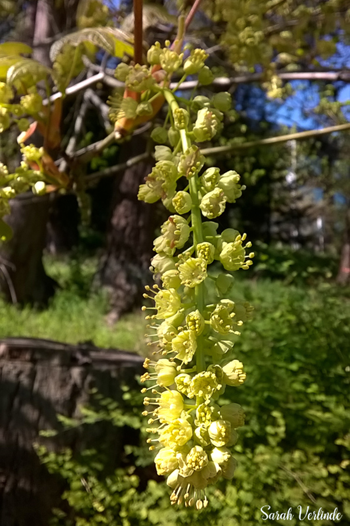Big-Leaf Maple
Acer macrophyllum – Big-leaf Maple
At a Glance:

- Family: Sapindaceae
- Plant Type: Large multi-trunked tree
- Distribution: Western North America, North California to Alaska
- Habitat: Moist woods, sea level to mid-elevations
- Height: 10-40m
- Flower: large racemes/clusters of pale yellow-green flowers hanging down.
- Flower Season: March – June
- Fruits: green to brown bristly samaras with wings spread closely – “helicopters”
- Leaves: Very large (4-12” across) deeply lobed leaves
- Generation: Perennial
- Notable feature: large leaves and great yellow fall color
Restoration and Conservation
Often found growing in disturbed areas like land cleared by fire or logging, Acer macrophyllum will sprout quickly from its stump and can grow over three meters in a year. Big-leaf maples often grow with many trunks and will drop its lower branches as it matures. This creates many nooks and crannies in the tree, providing ideal housing for birds and small mammals. The branches on the ground provide woody debris for other plants to germinate on, and shelter for small animals like insects and salamanders. Acer macrophyllum provides plenty of tall space for epiphytes (commonly called air plants that don’t need soil) like mosses, liverworts, and ferns – especially the licorice fern (Polypodium glycyrrhiza).
Ethnobotany
Big-leaf maples have been used by Native American tribes to make medicine for sore throats. It is called the ‘paddle tree’ in many Native American languages bacause the wood was often used for paddles as well as spindle whorls and other tools. The large leaves were used as temporary containers. The sap is sometimes used for making maple syrup, although Acer macrophyllum produces much less sap compared to Acer saccharum the sugar maple.
References and Resources
- FEIS/USDA: https://www.fs.fed.us/database/feis/plants/tree/acemac/all.html
- OSU: http://owic.oregonstate.edu/bigleaf-maple-acer-macrophyllum
- Pojar, J and MacKinnon, A. 2004. Plants of the Pacific Northwest Coast: Washington, Oregon, British Columbia and Alaska. Vancouver (BC): Lone Pine Publishing.
- WTU Image Herbarium: http://biology.burke.washington.edu/herbarium/imagecollection/taxon.php?Taxon=Acer%20macrophyllum
This article was written by Jessica Rouske and Sarah Verlinde. For questions regarding the UWB/CC Plant Tour, contact Sarah at severlin@uw.edu.
